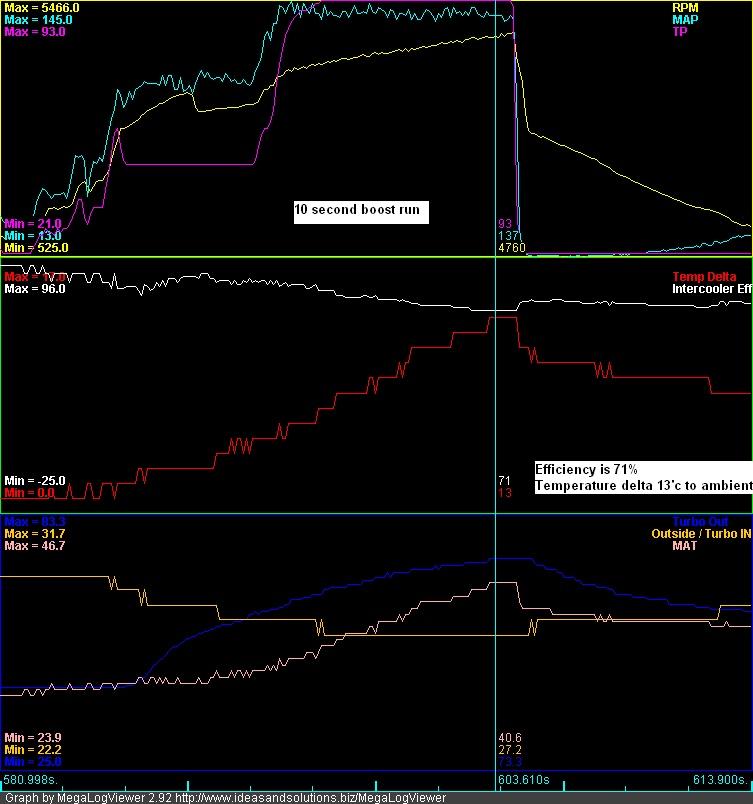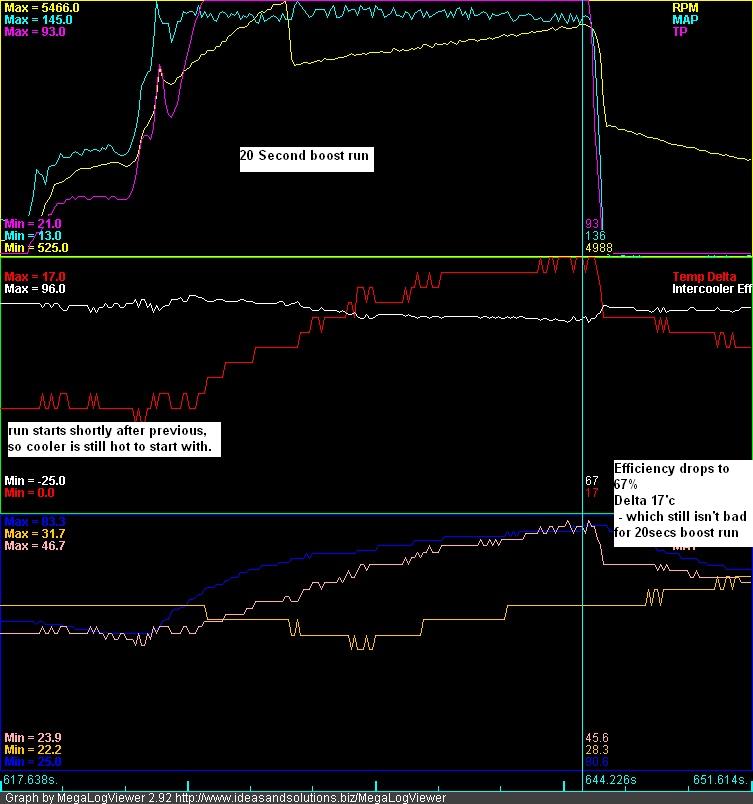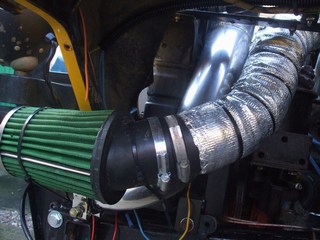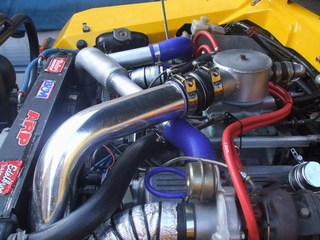Optimising Intake Temperatures On Forced Induction
Discussion
I'm underinformed on how get the best out of my turbo and the temperature of the intake air is something I'd like to optimise.
So - ignoring that bigger intercoolers are the obvious answer..what about the rest of the plumbing?
I'm using my 944T as my specific example but feel free to chip in with general knowledge on how these things work.
If we start at the compressor exit - how hot will the charge be leaving it at? In my case the charge goes down black 'rubber' tubing, past the block and into the intercooler.
Black is the best colour for radiating OR absorbing heat. So if the charge is hot enough then that's best for radiating heat away. But if it's cool it's picking up heat from the (in my case) pretty hot engine bay.
The rubberised hosing - good insulator from the engine bay heat or 'bad' insulator keeping the heat in?
There are obvious solutions to this in the form of aluminium hard pipes. But that gives you the opposite effects from the above ie aluminium has great heat transfer - but are you gaining or losing in the battle for lower temperatures. Silver is the worst radiative/absorbant colour but aluminium beats rubber hands down as a conductor.
And is the difference marginal or noticable? Obviously I'm toying with some aluminium hard pipes (they look great and the retailers promise much) but I'd much rather listen to neutral observers with experience.
A Heath-Robinson idea hit me of encasing all the intake plumbing inside that aluminium ducting that boy racers often use to channel cold air to their air filter - if it had a cool air feed then it's effectively a bodged up additional intercooler/insulator from engine heat. But if it's a good idea why hasn't someone clevererer than me done it already?
The intercooled air obviously wants to be kept cool too (not too bad in my case - shortish transit and not too close to the block).
And since it's pretty warm in the engine bay.....lag the hot bits? Exhaust lagging is well known but how about turbo lagging?
Yeah, I know - get a better intercooler. But once you have the biggest one you can cram in where do you go?
So - ignoring that bigger intercoolers are the obvious answer..what about the rest of the plumbing?
I'm using my 944T as my specific example but feel free to chip in with general knowledge on how these things work.
If we start at the compressor exit - how hot will the charge be leaving it at? In my case the charge goes down black 'rubber' tubing, past the block and into the intercooler.
Black is the best colour for radiating OR absorbing heat. So if the charge is hot enough then that's best for radiating heat away. But if it's cool it's picking up heat from the (in my case) pretty hot engine bay.
The rubberised hosing - good insulator from the engine bay heat or 'bad' insulator keeping the heat in?
There are obvious solutions to this in the form of aluminium hard pipes. But that gives you the opposite effects from the above ie aluminium has great heat transfer - but are you gaining or losing in the battle for lower temperatures. Silver is the worst radiative/absorbant colour but aluminium beats rubber hands down as a conductor.
And is the difference marginal or noticable? Obviously I'm toying with some aluminium hard pipes (they look great and the retailers promise much) but I'd much rather listen to neutral observers with experience.
A Heath-Robinson idea hit me of encasing all the intake plumbing inside that aluminium ducting that boy racers often use to channel cold air to their air filter - if it had a cool air feed then it's effectively a bodged up additional intercooler/insulator from engine heat. But if it's a good idea why hasn't someone clevererer than me done it already?
The intercooled air obviously wants to be kept cool too (not too bad in my case - shortish transit and not too close to the block).
And since it's pretty warm in the engine bay.....lag the hot bits? Exhaust lagging is well known but how about turbo lagging?
Yeah, I know - get a better intercooler. But once you have the biggest one you can cram in where do you go?
planetdave said:
Yeah, I know - get a better intercooler. But once you have the biggest one you can cram in where do you go?
You consider a more efficient intercooler, or look at a chargecooler.. Air-to-water cooling, this may present a packaging issue as you'll need to factor in a second rad to cool the chargecooler fluid, but it works very well on my roadster (1.4bar boost in a rather hot engine bay...) and also works well on Redvictor1 (although, this is with a large tank of water/ice in the boot!)slinky
Radiation is irrelevent unless you have components literally glowing hot. Even then, if you're looking at the effects of surface colour you need to think about the IR spectrum rather than the visible one, and the visible colour is a very poor indication of thermal emissivity.
Conduction is the real problem. Any hot components connected to the pipes will heat them and the heat will carry a long way down them, turning them into very effective air heaters. They will also pick up heat very effectively from any hot air blowing over them. In general, metal pipes without lagging will conduct like crazy - rubber hoses will be relatively well insulated.
Conduction is the real problem. Any hot components connected to the pipes will heat them and the heat will carry a long way down them, turning them into very effective air heaters. They will also pick up heat very effectively from any hot air blowing over them. In general, metal pipes without lagging will conduct like crazy - rubber hoses will be relatively well insulated.
Make sure the intecoolers well shrouded to ensure all air goes through it not round it.
I've steel intercooler pipes on my car, cold side wrapped in reflective heat wrap, hot side connected to the turbo with a silicon joiner.
I don't run a lot of boost 12psi and my AIT temps taken immediately before thottle body ae never more than 5 / 7 oC above ambient.
I've steel intercooler pipes on my car, cold side wrapped in reflective heat wrap, hot side connected to the turbo with a silicon joiner.
I don't run a lot of boost 12psi and my AIT temps taken immediately before thottle body ae never more than 5 / 7 oC above ambient.
You mean like 'how hot will the charge be leaving it at' (the turbo).
I tried but nobody wanted to say. I don't know any of these things and was fishing for info so I could get my head round the problem (and whether it is a problem).
You ask on PH and you don't know where it's going to end. Usually somewhere else and often with a big row in the middle
I tried but nobody wanted to say. I don't know any of these things and was fishing for info so I could get my head round the problem (and whether it is a problem).
You ask on PH and you don't know where it's going to end. Usually somewhere else and often with a big row in the middle

After 10 seconds of boost, turbo Inlet 27'c, turbo outlet 73'c, manifold temp 40'c, delta 17'c, efficiency 71%

After 20 seconds of boost, turbo Inlet 28'c, turbo outlet 90'c, manifold temp 45'c, delta 17'c, efficiency 67%

The biggest problem I have is getting cool air into the turbos, only way to get them down is to place the air filters in front of the front body work, I also insultated them which helps a little:


Anywhere beyond the front of the car, results in sucking warm air in from the engine bay.
So in summary, insulate the intakes and feed cool air, dont worry about the output - insulate post intercooler if you feel there is a problem.

After 20 seconds of boost, turbo Inlet 28'c, turbo outlet 90'c, manifold temp 45'c, delta 17'c, efficiency 67%

The biggest problem I have is getting cool air into the turbos, only way to get them down is to place the air filters in front of the front body work, I also insultated them which helps a little:
Anywhere beyond the front of the car, results in sucking warm air in from the engine bay.
So in summary, insulate the intakes and feed cool air, dont worry about the output - insulate post intercooler if you feel there is a problem.
Hi there
If you are determent to get the most out of your turbo you'd be better off concentrating on your load pressure and your compression rate (including fuel values).
Cooling down intake air comes after that, you can squeeze a extra few BHP's cooling down your intercooler as Subaru does with a water jet, having said that, for driving in non competition environment the advantage in power gain is useless and hardly noticeable on an engine with a significant load pressure.
If you want power, lower your compression rate and up your load pressure, playing with air intake temps is not worth it for road use.
Obviously you want to keep your intercooler as far from the turbo as possible for to prevent heat radiant heat warming up the intercooler and the intake air.
Hope this info is useful to you.
GMTECH
If you are determent to get the most out of your turbo you'd be better off concentrating on your load pressure and your compression rate (including fuel values).
Cooling down intake air comes after that, you can squeeze a extra few BHP's cooling down your intercooler as Subaru does with a water jet, having said that, for driving in non competition environment the advantage in power gain is useless and hardly noticeable on an engine with a significant load pressure.
If you want power, lower your compression rate and up your load pressure, playing with air intake temps is not worth it for road use.
Obviously you want to keep your intercooler as far from the turbo as possible for to prevent heat radiant heat warming up the intercooler and the intake air.
Hope this info is useful to you.
GMTECH
planetdave said:
You mean like 'how hot will the charge be leaving it at' (the turbo).
I tried but nobody wanted to say. I don't know any of these things and was fishing for info so I could get my head round the problem (and whether it is a problem).
You ask on PH and you don't know where it's going to end. Usually somewhere else and often with a big row in the middle
No, I asked what are your current intake charge temps ?? How the hell would anyone else know what they are, if you dont ???I tried but nobody wanted to say. I don't know any of these things and was fishing for info so I could get my head round the problem (and whether it is a problem).
You ask on PH and you don't know where it's going to end. Usually somewhere else and often with a big row in the middle

May I refer the honourable gentleman to my first post.
I'm looking for ballpark figures and generalities so I can get a mental picture of what's going on. I obviously know bugger all about the details at the moment. I was hoping this thread would teach me useful stuff and maybe stop me splashing cash on outrageous crap that gets sold to idiots.
I'm looking for ballpark figures and generalities so I can get a mental picture of what's going on. I obviously know bugger all about the details at the moment. I was hoping this thread would teach me useful stuff and maybe stop me splashing cash on outrageous crap that gets sold to idiots.
planetdave said:
I did learn useful stuff.
Go into 'engines and drivetrain' and they take the piss after not bothering to read the posts.
Cheers guys.
Well earlier on you said:Go into 'engines and drivetrain' and they take the piss after not bothering to read the posts.
Cheers guys.
planetdave said:
I tried but nobody wanted to say. I don't know any of these things and was fishing for info so I could get my head round the problem (and whether it is a problem).
Now stevieturbo has asked you the very first question you have to answer to decide whether you have a problem. So now you can either go off in a huff, or take a bit of p!ss taking in your stride and take advantage of the hints that came with it.planetdave said:
May I refer the honourable gentleman to my first post.
I'm looking for ballpark figures and generalities so I can get a mental picture of what's going on. I obviously know bugger all about the details at the moment. I was hoping this thread would teach me useful stuff and maybe stop me splashing cash on outrageous crap that gets sold to idiots.
Cheapest way to stop splashing cash on crap, is to determine if there is a problem in the first place.I'm looking for ballpark figures and generalities so I can get a mental picture of what's going on. I obviously know bugger all about the details at the moment. I was hoping this thread would teach me useful stuff and maybe stop me splashing cash on outrageous crap that gets sold to idiots.
Your post is perfectly clear.....as mud.
You want info on your setup....which nobody can know.
The only answer I can give you with any accuracy, is the air exiting the turbo, will be hot.
You cant compare with other setups....unless perhaps someone is using your exact same setup, turbo, car, boost, IC etc etc etc and they have done the testing for you.
Idiots go out and buy the crap, because they dont do any real testing themselves to see if they need it in the first place, and instead, just ask the magical internet for answers.
Best thing to do is buy some cheap digital temp sensors, stick them in the air flow at strategic points and see what the values are. That will tell you if there is a problem and if it is worth doing anything about. It also means that you can see if anything that you do improves or makes the situation worse.
Turbo exit temps can be anything from 25°C to 85°C Depending on the following:
Ambient air entry
Level of boost
Size of turbo
Compressor efficiency
Inlet back pressure to turbo
throttle position
Exhaust temperature
And I dare say there are a few more,
hopefully you now see why direct measurement of what you have is a best place to start
the most accurate way to do this would be to fit an air temp sensor in the pipe exiting the turbo, you could also use those little temperature stickers on the outside of the pipe but these would be effected by the surrounding hot parts
Matt
Ambient air entry
Level of boost
Size of turbo
Compressor efficiency
Inlet back pressure to turbo
throttle position
Exhaust temperature
And I dare say there are a few more,
hopefully you now see why direct measurement of what you have is a best place to start
the most accurate way to do this would be to fit an air temp sensor in the pipe exiting the turbo, you could also use those little temperature stickers on the outside of the pipe but these would be effected by the surrounding hot parts
Matt
Gassing Station | Engines & Drivetrain | Top of Page | What's New | My Stuff





